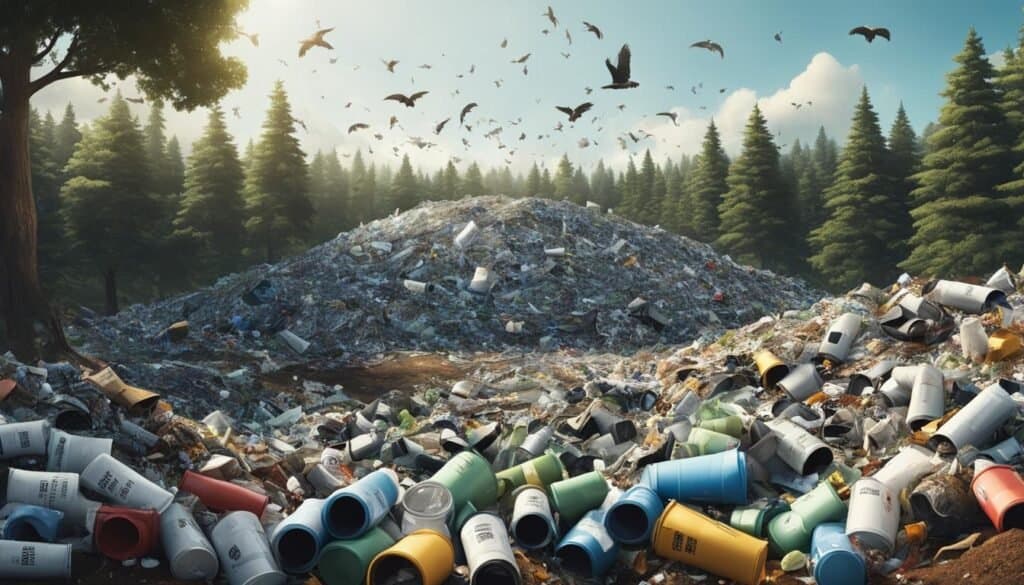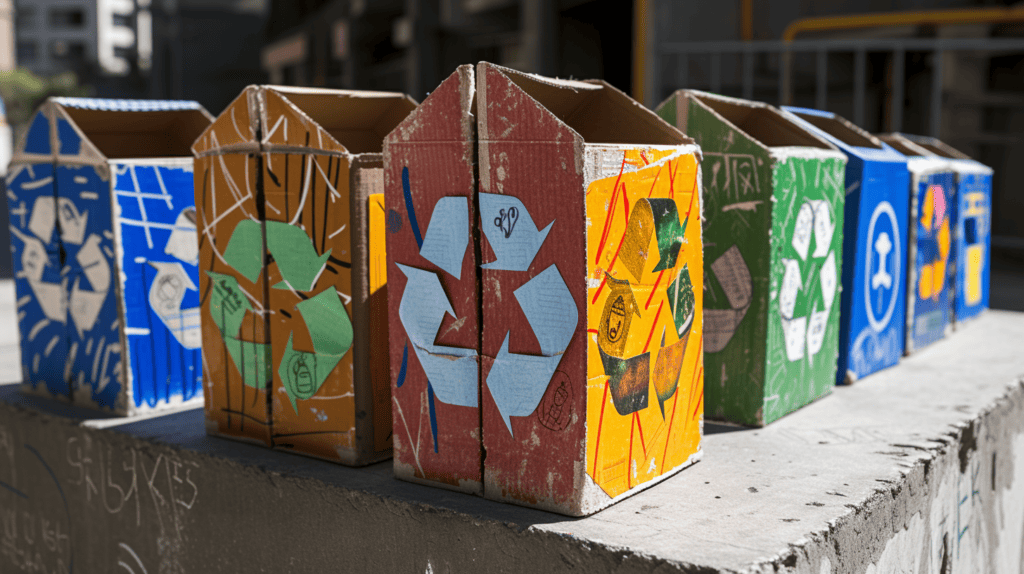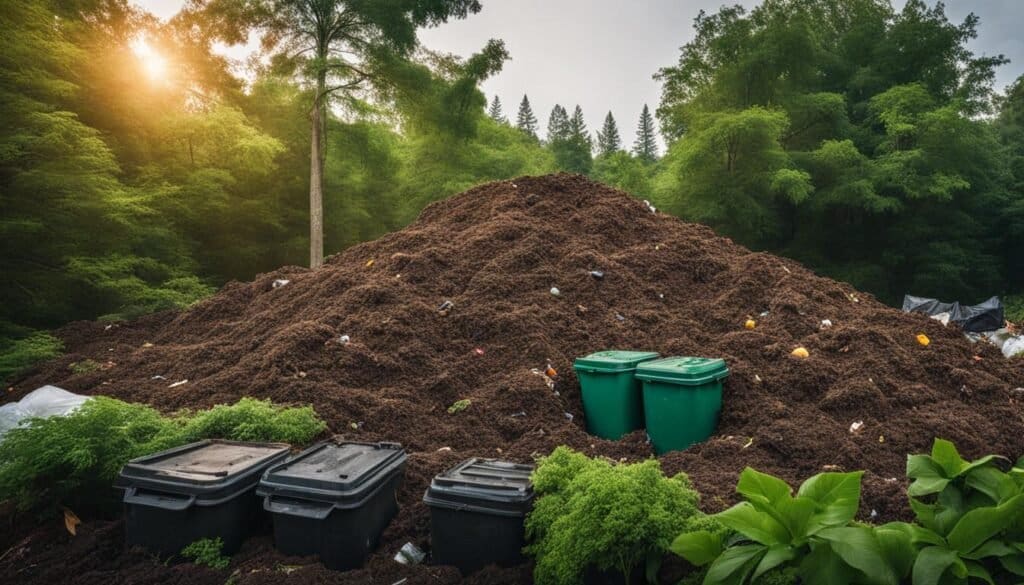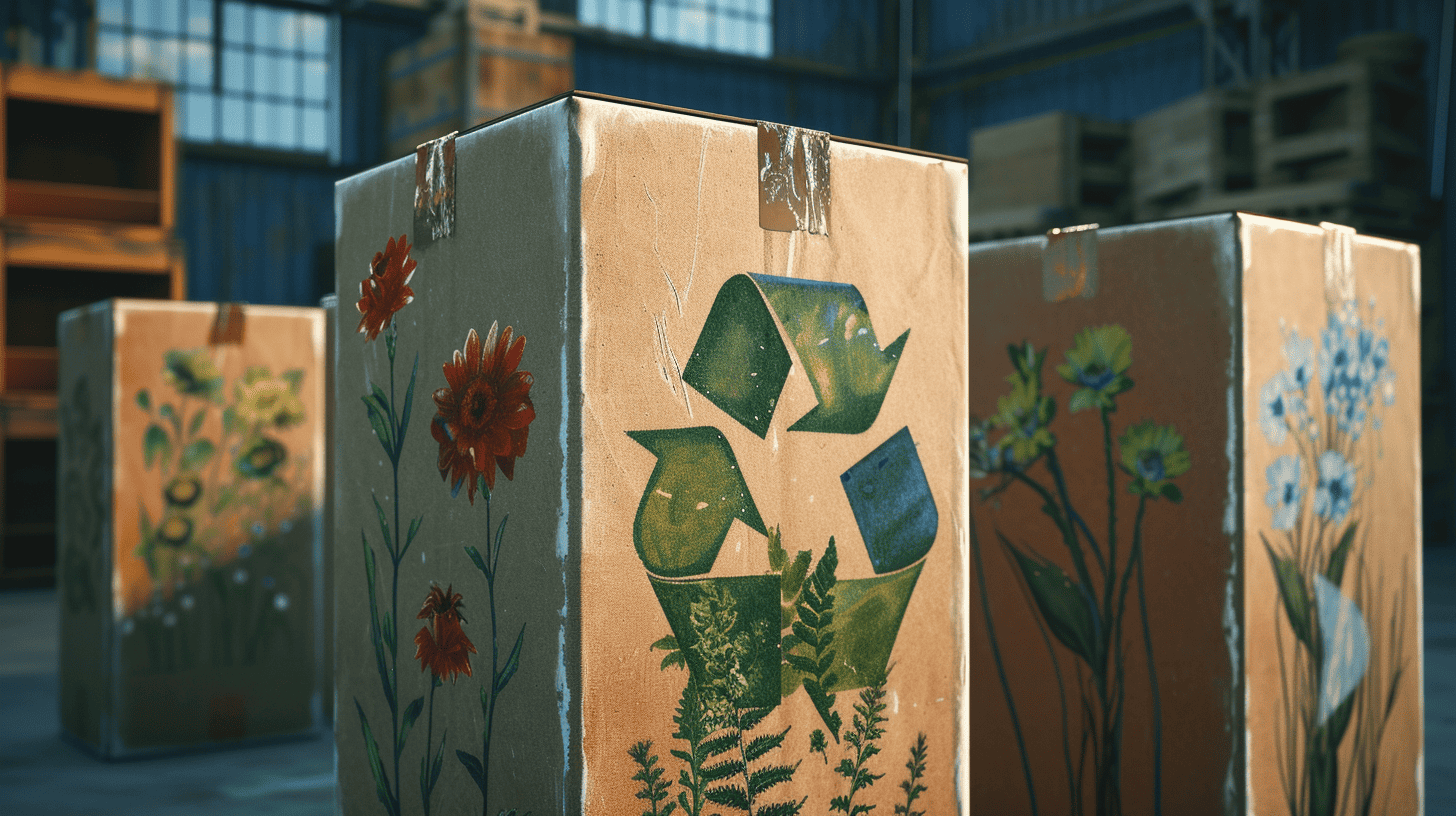Whether you’re just starting to live more sustainably or you’ve been an eco-champion for years, you’ve inevitably come across the terms “biodegradable” and “compostable” on various product labels and packaging. However, making eco-friendly choices requires understanding the distinctions between these labels and how each impacts the environment. In this article, we’ll explore the critical differences between biodegradable and compostable products, so you can make informed decisions that benefit our planet.
Key Takeaways
- Biodegradable and compostable are not interchangeable terms
- Understanding the differences between the two is essential for making eco-friendly choices
- Biodegradable products break down naturally but may release harmful substances and have no specified time frame for decomposition
- Compostable products fully degrade into nutrient-rich compost within a specified period and without harmful residues
- Industry standards regulate compostable products, ensuring they meet environmental specifications and contribute positively to soil health
- Biodegradable products often lack stringent regulations and may pose environmental risks if not disposed of correctly
- Consider the environmental impact of both biodegradable and compostable products when making informed decisions
Biodegradable vs Compostable Product Differences
Here is a comprehensive table comparing key differences between biodegradable and compostable products:
| Biodegradable | Compostable | |
|---|---|---|
| Definition | Breaks down through natural processes like exposure to heat, light, air, moisture etc. over months or years | Breaks down through composting in weeks/months under controlled conditions |
| Materials | Can be plant-based (corn, sugarcane etc.) or petroleum-based | Must be plant-based materials only |
| End products | CO2, water, methane, biomass. Can sometimes leave behind toxic residue | CO2, water, compost. No toxic residue |
| Conditions to break down | Can break down in landfills, water bodies etc. Rate of breakdown depends on conditions | Requires commercial composting facilities with specific temperature, moisture levels |
| Certification | No universal standard. Can be misleading | Strict specifications by organizations like BPI. Compostable certification ensures suitability for commercial composting |
| Recyclability | Not always recyclable | Not recyclable. Needs separate collection for industrial composting |
| Common products | Plastic bags, containers, packaging films, mulch films | Food service items like cutlery, cups, takeout containers |
In summary, while biodegradable products break down over time, compostable products break down much faster under controlled composting conditions and leave no toxic residue. Compostable products also need to meet strict industry specifications in order to be certified compostable.
Deciphering Eco-Friendly Terms: Clarity on Biodegradable and Compostable
In the quest for sustainable living, understanding the differences between compostable and biodegradable materials is crucial for product labeling accuracy and environmentally responsible decisions. Both terms involve breaking down materials into a more natural state, but their processes and implications for the environment differ significantly, sometimes leading to confusion among eco-conscious consumers.
Comprehending what biodegradable means is the first step in differentiating these eco-friendly terms. A biodegradable product is one that can decompose naturally into simpler substances, thanks to agents like bacteria and fungi. However, this term does not necessarily guarantee the absence of toxic substances in the end product or a specific time frame for decomposition.
On the other hand, compostable materials not only break down but also transform into nutrient-rich compost within a defined period and under specific conditions. This process ensures that the final product enriches soil health without leaving behind toxic chemicals or harming the environment in any way.
Thus, differentiating between these terms is vital for ensuring that eco-friendly products meet consumers’ environmental expectations.
To further clarify the differences between the two, consider the table below:
| Aspect | Biodegradable | Compostable |
|---|---|---|
| Breakdown process | Decomposes into simpler substances | Decomposes into nutrient-rich compost |
| Toxic byproducts | Possible, but not specified | None |
| Time frame for decomposition | Not specified | Within a defined period |
| Contribution to soil health | Uncertain | Yes, nutrients returned to the soil |
As a consumer, differentiating between compostable and biodegradable products can inform your eco-friendly decisions and ensure you choose responsible options that align with your values. Therefore, it is crucial to understand and discern what these terms truly mean before making purchasing choices on your journey to sustainable living.
Biodegradable and Compostable: Understanding the Fundamental Differences
The difference between compostable and biodegradable products stems from their varying impact on the environment and the timeline of their decomposition process. While both terms describe materials that undergo natural decomposition due to microorganisms, grasping their distinctions is crucial for making eco-conscious decisions.
Biodegradable items break down into smaller components over time, but they don’t have a defined decomposition period. Moreover, they might leave behind traces of harmful substances. On the other hand, compostable materials must meet stringent industry regulations set forth by the ASTM D6400 and D6868, ensuring that they return to the earth as nutrient-rich, non-toxic compost within a specific timeframe.
Biodegradable vs Compostable: while both materials break down, compostable materials do so within a set time and contribute positively to soil health without any harmful residues.
To delve deeper into the contrasts between these eco-concepts, let’s consider the following table:
| Criteria | Biodegradable | Compostable |
|---|---|---|
| Environmental Impact | May leave harmful residues | No harmful residues |
| Decomposition Time | No specific timeline | Well-defined timeline (usually around 90 days) |
| Regulations | Loosely regulated | Strict industry standards (ASTM D6400 and D6868) |
Recognizing these fundamental differences is crucial for selecting products that alleviate your environmental footprint. In summary, compostable products offer higher environmental benefits than biodegradable ones, as they breakdown within a set period and yield nutrient-rich, non-toxic compost. Given that compostable materials adhere to strict industry standards, you can feel confident that your sustainable choices have a tangible, positive environmental effect.
Unveiling the True Meaning of “Compostable”: A Closer Look at Certification and Standards
Unraveling the concept of compostability requires an examination of certifications and standards that clarify eco-friendly materials and highlight their environmental benefits. By understanding the regulatory benchmarks, such as ASTM D6400 and D6868, confidence in the eco-labeled products is fostered, ultimately benefiting the planet.
ASTM D6400 and ASTM D6868 Requirements
These ASTM standards help define and regulate the accelerated degradation of compostable materials in industrial compost environments. They require the materials to decompose within 90 days under specific conditions, resulting in an Eco-friendly, non-toxic compost that causes minimal harm to the environment.
Seed Germination Trial and Breakdown Rate
In addition to the compliance with ASTM standards, compostable products undergo seed germination trials. This process verifies the resulting compost’s efficacy in promoting plant growth and contributes positively to the environment. This further solidifies the compostable definition, as it ensures the materials have not only degraded but are also beneficial to the ecosystem.
Composting Standards and Product Verification
Adhering to high composting standards ensures the products we use are indeed eco-friendly. Through certification and regulation, manufacturers can demonstrate their dedication to producing materials that align with these standards. Engaging in proper industrial compost methods minimize waste and contribute to a healthier compost environment.
Ultimately, recognizing and understanding the difference between biodegradable and compostable products is crucial for responsible consumption. By seeking out products that adhere to regulated degradation standards, we support a more sustainable future and contribute to preserving our shared environment.
The Broad Spectrum of “Biodegradable”: Assessing the Risks of Vague Labels

The term “biodegradable” encompasses a wide variety of materials, leading to less stringent regulatory requirements compared to their compostable counterparts. Consequently, this broad biodegradable definition poses several environmental risks due to the lack of standardization. Products claiming to be biodegradable might take an indefinite time to decompose or even release harmful substances during the process. Therefore, it is crucial for consumers to approach vague biodegradable claims with caution and recognize the importance of specified decomposition conditions for proper degradation.
Lack of Regulation for Biodegradable Claims
Biodegradable products often come with unregulated claims, making it difficult for consumers to verify their authenticity. Unlike compostable products, which are required to comply with strict industry standards like ASTM D6400 and D6868, biodegradable items may not undergo such rigorous testing. This lack of regulation can lead to the production and distribution of items that do not meet environmentally friendly criteria, posing potential threats to both ecological systems and uninformed consumers.
Disposal Challenges and Environmental Impact
Another concern related to biodegradable products is the challenges they present with proper disposal. In some cases, biodegradable items might not decompose effectively in landfills due to limited exposure to oxygen, inadequate moisture, and other unfavorable conditions. In addition, the release of microplastic waste and other pollutant residues during decomposition can negatively affect our environment. Therefore, understanding the environmental implications of disposing of biodegradable materials—be it in landfills or natural settings—is essential to minimizing harmful side effects on our planet.
Biodegradable vs Compostable Product Differences: A Side-by-Side Analysis
When it comes to eco-friendly products, the choice between biodegradable and compostable items plays a crucial role. A direct comparison between these materials illuminates the significant contrasts in environmental impact, material composition, and time frames for degradation.
Environmental Benefits & Impact
Compostable items provide a clear advantage in terms of their environmental benefits. These products degrade rapidly and contribute positively to soil health, leaving behind no toxic byproducts. Biodegradable materials, on the other hand, can vary widely in their eco-friendliness depending on their chemical makeup. This makes it important to weigh the potential environmental consequences and benefits before making a choice between the two types of products.
Material Composition and Degradation Time
Another critical consideration when comparing biodegradable and compostable products is the material’s composition and the expected time frame for degradation. Compostable materials boast a rapid degradation rate of approximately 90% in 180 days, while meeting specific industry standards that ensure they leave behind no harmful residues. In contrast, biodegradable materials can take longer to degrade and may leave behind microplastic waste, which poses significant ecological risks. The table below provides a side-by-side comparison of these key factors for biodegradable and compostable items:
| Factors | Biodegradable Items | Compostable Items |
|---|---|---|
| Environmental Impact | Varies based on chemical makeup; may leave behind harmful residues or microplastics | Typically positive; contributes to soil health without negative residues or microplastics |
| Material Composition | Derived from various sources; no specific standards or guidelines for composition | Consistently certified to meet industry and ASTM standards for compostability |
| Decomposition Time | Indefinite time frame; no specific guidelines for degradation duration | Approximately 90% in 180 days; must meet specific time frame guidelines for decomposition |
In conclusion, understanding the key differences between biodegradable and compostable items is crucial for those wanting to choose environmentally responsible products. By considering factors such as environmental impact, material composition, and degradation time, individuals can make informed decisions that align with their personal values and contribute positively to organic waste recovery efforts.
How to Identify and Choose Sustainable Packaging Options

Identifying truly sustainable packaging requires comprehensive analysis and a commitment to circular economy principles. Life cycle assessments provide insight into the environmental footprint of a product from production to disposal, informing more sustainable manufacturing practices. The circular economy undergirds this by promoting the design of goods and packaging that can be reused or reintegrated into the production cycle, thereby reducing waste. Compostable and biodegradable packaging play pivotal roles in this approach, offering alternatives that align with recovering organic waste as a resource rather than contributing to landfill burden.
Life Cycle Assessment for Sustainable Improvements
A life cycle assessment (LCA) is a powerful analytical tool that evaluates the environmental impacts of a product from cradle to grave. This comprehensive approach accounts for all stages of a product’s life, from raw material extraction to manufacturing, distribution, use and disposal, offering insights into potential improvements and the trade-offs between different packaging options. By conducting an LCA, manufacturers can pinpoint areas of their processes and products that require enhancement and make strategic decisions to reduce their ecological footprint.
The Role of Circular Economy in Packaging Decisions
Embracing the circular economy means moving away from the traditional take-make-waste linear model to a system where waste is minimized, and resources are continually cycled back into the production process. Packaging involves designing products that can be easily recycled, reused, or composted, harnessing technological innovations and eco-design principles to achieve a more sustainable outcome. Some key strategies include:
- Opting for compostable packaging that breaks down into nutrient-rich compost with minimal impact on the environment.
- Choosing biodegradable or recyclable packaging materials that minimize the amount of waste sent to landfills.
- Implementing reusable packaging systems that can be cleaned and returned to circulation multiple times, such as glass bottles or returnable containers.
- Incorporating recycled content in packaging materials to support the adoption of recycled materials and drive demand for recycling programs.
By taking these eco-friendly choices into account, businesses and consumers can make a significant impact on waste reduction, contributing to a healthier planet for current and future generations.
Expanding Beyond “Biodegradable” and “Compostable”: Other Key Eco-Terms
Moving past the biodegradable and compostable language, it’s crucial to be aware of additional eco-terms such as “degradable” and “oxo-degradable,” which can often be misleading and contribute to greenwashing. While understanding the nuances of these terms is essential for making informed decisions, it’s also vital to recognize potential greenwashing tactics in marketing.
Confronting Misleading Terms Like “Degradable” and “Oxo-Degradable”
Degradable products claim to break down over time, yet they lack specific standards for the timescale of the disintegration process and whether the decomposition is harmless to the environment. Similarly, oxo-degradable items can be misleading, as they often boast faster disintegration but are known for releasing environmentally toxic microplastics during their breakdown. These types of products are prominent examples of misleading marketing in the realm of eco-terms.
Recognizing Greenwashing and its Impact on Consumer Choices
Greenwashing denotes the practice of suggesting a product’s environmental responsibility without substantiated claims, potentially steering consumers towards choices that are not as eco-friendly as they may appear. These misleading environmental buzzwords can undermine genuine sustainability efforts, highlighting the importance of properly identifying and understanding eco-terms to ensure informed decision-making regarding product disposal and environmentally responsible consumption.
Compost Contamination and Its Effects on Sustainability Efforts

Compost contamination poses a significant challenge for those striving to achieve environmental sustainability. When materials are labeled as biodegradable but do not carry compostable certification, it can disrupt the integrity of the composting process. The presence of these contaminants hinders the creation of high-quality, hazard-free compost due to their potential incompatibility or toxicity. The negative impact of contamination ultimately undermines efforts to protect the environment.
To combat this issue, it is crucial for both manufacturers and consumers to properly segregate waste and follow clear labeling guidelines for compostable and biodegradable products. Being mindful of the differences between these terms will help ensure the preservation of the compost’s fertility and usability. To illustrate the consequences of improper waste disposal and its effects on compost quality, let us examine the following table:
| Imperfections in Compost | Environmental Effects | |
|---|---|---|
| Incompatible Materials | Lack of nutrient absorption due to material imbalances | Inability to enrich plant growth, potentially harming soil health and crop yield |
| Toxic Elements | Contamination of compost by harmful substances released during decomposition | Ecological damage caused by the spread of toxins to water sources, wildlife, and ecosystems |
| Slow Degradation | Decreased efficiency in composting process as it struggles to break down contaminating materials over time | Higher demand for landfills to manage waste that cannot be composted and reused |
“A moment of patience in a moment of anger saves you a hundred moments of regret.”
As we work towards a greener future, it is essential to recognize the importance of proper waste segregation and avoid contaminating our composting efforts. By educating ourselves about the differences between compostable and biodegradable materials, as well as implementing best practices for waste disposal, we can significantly reduce the contamination impact and bolster our goal of achieving environmental sustainability.
Good to Know: International Standards Guiding Eco-Friendly Product Choices
International standards play a significant role in guiding environmentally responsible product choices. By following established criteria set forth in standards such as the European Standard and the US Standard ASTM, manufacturers provide a reliable framework for businesses to accurately label their products as biodegradable and compostable. Let’s delve deeper into the key international standards shaping the eco-friendly choices landscape.
European and US Standard ASTM Guidelines
When it comes to ensuring product compliance with eco-friendly standards, the European Union embraces the EN 13432 standard, whereas, in the United States, the primary ASTM standards are ASTM D6400 and ASTM D6868. These guidelines assist manufacturers in creating products that comply with biodegradable and compostable regulations, offering consumers a clear understanding of how each product aligns with the tenets of ecological stewardship.
Zero Waste Initiatives and Compliance
Beyond the scope of the European Standard and ASTM, zero waste initiatives also contribute significantly to promoting environmentally sustainable product choices. The Zero Waste International Alliance (ZWIA) advocates for products and packaging materials that can be seamlessly integrated back into the ecosystem without detrimental side effects. By adhering to these norms and embracing a zero waste approach, manufacturers can effectively minimize their environmental impact and help consumers make informed purchasing decisions.
- European Standard EN 13432
- US Standard ASTM D6400 and D6868
- Zero Waste International Alliance
Ultimately, understanding and adhering to international standards enable manufacturers and businesses to provide eco-friendly solutions that meet or exceed environmentally conscious consumers’ expectations. By familiarizing themselves with these important guidelines and the zero waste mindset, individuals can make more informed choices, contributing positively to the global shift toward a sustainable future for our planet.
Conclusion on Biodegradable vs Compostable Product Differences
In conclusion, understanding the distinction between biodegradable and compostable products is an essential component of sustainable living and environmentally responsible consumption. As we continue on our quest for a healthier planet, making informed choices about product consumption and disposal becomes ever more critical. Recognizing the environmental implications of each label and opting for products that align with rigorous standards not only minimizes one’s ecological footprint but also propels society towards a sustainable future.
As sustainability becomes more intrinsic to our lifestyle choices, grasping the nuances of these terms empowers individuals and communities to contribute meaningfully to the health and well-being of our shared environment. By shedding light on the differences between biodegradable vs compostable materials, we can make a positive impact on the future of our planet by understanding the complexities of these concepts and making informed decisions accordingly.
So the next time you find yourself weighing the pros and cons of purchasing biodegradable or compostable products, remember that becoming educated on these topics is a significant step towards cultivating environmentally responsible habits. Together, we can make significant strides in fostering a sustainable world, ensuring a brighter future for generations to come.
FAQ on Recyclable Materials
Q: What does ‘compostable’ mean?
A: ‘Compostable’ means that a product is capable of breaking down into natural elements in a compost environment, leaving no toxicity in the soil. It is a specific and regulated term that describes products that break down into carbon dioxide, water, inorganic compounds, and biomass at a rate consistent with other known compostable materials.
Q: What does ‘biodegradable’ mean?
A: ‘Biodegradable’ means that a product can be broken down by microorganisms such as bacteria, fungi, or algae, over time. The term is often used to describe organic materials, including organic matter, that can decompose into natural elements within a specific timeframe under specific conditions.
Q: What is the difference between ‘compostable’ and ‘biodegradable’?
A: The main difference lies in the conditions and timeframe in which the breakdown occurs. ‘Compostable’ products break down in a composting facility or home compost environment within a specific timeframe, leaving no toxicity in the soil. On the other hand, ‘biodegradable’ products can break down over time by naturally occurring microorganisms such as bacteria, fungi, or algae, but the timeframe and conditions may vary.
Q: Are all compostable products biodegradable?
A: Yes, all compostable products are biodegradable, but not all biodegradable products are compostable. Compostable products are designed to break down in a compost environment into natural elements and leave no toxicity, making them inherently biodegradable.
Q: What are some examples of compostable products?
A: Compostable products include food scraps, yard waste, certified compostable bags, and biodegradable packaging that is specifically labeled as being suitable for composting. These products can be broken down in composting facilities or home compost systems.
Q: How are compostable products different from regular plastic?
A: Compostable products have the ability to break down into natural elements within a specific timeframe in a compost environment. In contrast, regular plastic does not break down easily and can persist in the environment for a long time, causing environmental pollution.
Q: Can compostable products be disposed of in regular recycling bins?
A: No, compostable products should not be disposed of in regular recycling bins. They should be sent to composting facilities or home compost systems where they can break down into natural elements without leaving any toxicity in the soil.
Q: What are the benefits of using compostable products?
A: Using compostable products helps in recycling organic waste, reducing the amount of waste sent to landfills, and decreasing environmental pollution. They also contribute to the production of nutrient-rich compost that can be used to improve soil quality.
Q: Are all compostable products home compostable?
A: Not all compostable products are home compostable. Some may require specific conditions or processing that are only available in commercial composting facilities. It’s essential to check the product labeling for instructions on how to dispose of it properly.
Q: Can compostable products release carbon dioxide when breaking down?
A: Yes, during the breakdown process, compostable products release carbon dioxide, water, inorganic compounds, and biomass, similar to the breakdown of other organic materials. This natural process contributes to the carbon cycle without leaving harmful residues in the soil.





Leave a Reply